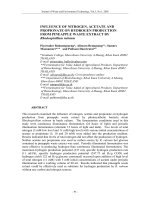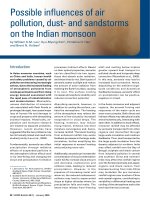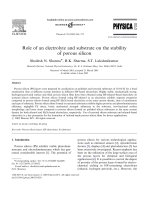Seafood enzymes utilization and influence on postharvest seafood quality
Bạn đang xem bản rút gọn của tài liệu. Xem và tải ngay bản đầy đủ của tài liệu tại đây (3.48 MB, 689 trang )
Preface
It has been over 100 years since Eduard Büchner showed that molecules with
catalytic activity could be isolated from yeast cells. Following decades of intensive research on these molecules (enzymes), we now know they are ubiquitous
in living systems and are the agents that make chemical reactions possible in a
diversity of life forms, albeit sometimes under vastly different environmental
conditions. In 1961, when the International Commission on Enzymes of the International Union of Biochemistry established a system to classify enzymes, the
committee listed only 712 enzymes. The total number of enzymes identified has
since grown to more than 3000.
Most of the known enzymes have been extensively studied in land mammals, such as rats, and microorganisms, such as Escherichia coli. So why devote
a book to enzymes from aquatic animals? Although most of the enzymes discussed in this book are also found in terrestrial life forms, homologous enzymes
from different sources, which have the same name and Enzyme Commission
(EC) number, may exhibit vastly different properties with respect to stability,
temperature optimum, secondary substrate specificity, and others. These differences are based on adaptation and are magnified when the cellular milieu of the
source organisms varies because of habitat conditions or other reasons. Aquatic
organisms occupy unique and often extreme environments, such as the deep
ocean where pressure is high and light is absent; temperature ranges from –2ºC
in Polar saline gradients to 103ºC at thermal vents; salinity ranges from very low
vii
Foreword
v
fish processing byproducts as processing aids. These discussions of the special roles of seafood enzymes in postmortem fish metabolism and the quality
changes they effect are critical pieces of knowledge in achieving the goal of
obtaining maximum value from the available species. We have a strong obligation to use seafood resources wisely and responsibly so future generations
may also enjoy their benefits.
Herbert O. Hultin, Professor
Department of Food Science
University of Massachusetts/Amherst
Gloucester Marine Station
Gloucester, Massachusetts
iv
Foreword
produce high-value materials (e.g., enzymes) and developing techniques to recover all the flesh and use it for human food.
Approximately half of all the species caught in the world today go into
the production of fish meal and oil. Development of procedures that will make
these resources directly available for human food would greatly improve their
efficiency of use. The chemical instability of both the protein and lipid fractions, the presence of high concentrations of unstable dark muscle, seasonal
fluctuations in catch, unfavorable sizes and shapes, strong flavors, and skeletal
structure that does not permit easy removal of bones are all factors limiting the
use of these species. Advances in our knowledge of the chemistry and biochemistry of the unstable components and improvement in processing procedures
will be necessary to adapt these species for human food. We must face and accept this challenge.
A thorough understanding of the nature of the critical components of
seafood tissues and how they respond to processing, storage, and handling
procedures is an absolute necessity to achieve these goals. No class of components of seafood tissues is more important than their enzymic systems. The
number of books or reviews devoted exclusively to seafoods is small compared to those dealing with the muscle tissue of land animals. Indeed, in many
cases land animals or birds have been used as models to discuss fishery problems. Although there are many similarities between the muscles of fish and
land animals, some important considerations for specific seafoods are often
overlooked or downplayed. One point often overlooked in discussions of
enzymes in foods is that most of the important commercial species are caught
in cold water. In fact, 95% of the ocean has a temperature of less that 5ºC
year-round, leading to species with lipids that contain a large percentage of
the highly unsaturated fatty acids eicosapentaenoic and docosahexaenoic
acids (which maintain fluidity of the lipids at low temperature). This makes
the lipid fraction susceptible to oxidation. Likewise, proteins (enzymes) of
seafoods must have a greater inherent flexibility to be able to function at low
temperatures—a flexibility that also makes them less stable. Thus, seafood
enzymes function well at low temperatures and refrigeration might not have
the same inhibitory effect on postmortem changes that it would for warmblooded land animals.
Seafood Enzymes covers a myriad of topics on how enzymes are important to improve uses of seafood raw materials. These topics include the nature
of the enzymes themselves and biological factors that affect them; the role of
native enzymes in postmortem effects on quality attributes such as texture,
flavor, and color; the use of products of enzymic breakdown as quality indices; control of enzymic activity by modification of environmental conditions, processing, or use of inhibitors; and the use of enzymes isolated from
Foreword
Gathering food from the oceans represents the last major hunting effort of humans. As has happened in other fields, however, our technological abilities have
outstripped our capacity to deal with the social, cultural, and economic consequences of these technologies. Where national and international regulations, exhortations, and pleas have failed, the common property status of sea resources
had led to overexploitation, which has reduced the number of animals available
to be used as foods. This decline has been accompanied by an increase in human
populations and, more importantly, rising expectations for improved diets in
newly developing areas of the world. These factors have increased demands on
fish and shellfish stocks and increased strains on the ability of the fish and shellfish to maintain their numbers. Quite naturally, this has had the most impact on
those species that have the greatest attraction as food for humans.
Traditionally, the fisheries have been a wasteful industry, in that often no
more than 50% of the flesh of even desirable species is converted to high-value
human food, and often much high-value seafood protein and lipid is dumped
back, unused, into the oceans. No one denies the great need to utilize our aquatic
resources more efficiently. It not only makes economic sense, but on a planet
with limited resources, there is a moral imperative not to needlessly destroy
valuable raw materials. First, we must use traditional commercial species to the
fullest extent. This means adding value by utilizing processing byproducts to
iii
Library of Congress Cataloging-in-Publication Data
Seafood enzymes : utilization and influence on postharvest seafood quality / edited by
Norman F. Haard and Benjamin K. Simpson.
p. cm — (Food science and technology ; 97)
ISBN 0-8247-0326-X (alk. paper)
1. Seafood—Composition. 2. Fishery processing—Quality control. 3. Enzymes. I.
Haard, N. F. II. Simpson, Benjamin K. III. Series.
TX556.5.S42 2000
664'.9497—dc21
99-087831
This book is printed on acid-free paper.
Headquarters
Marcel Dekker, Inc.
270 Madison Avenue, New York, NY 10016
tel: 212-696-9000; fax: 212-685-4540
Eastern Hemisphere Distribution
Marcel Dekker AG
Hutgasse 4, Postfach 812, CH-4001 Basel, Switzerland
tel: 41-61-261-8482; fax: 41-61-261-8896
World Wide Web
The publisher offers discounts on this book when ordered in bulk quantities. For more information, write to Special Sales/Professional Marketing at the headquarters address
above.
Copyright © 2000 by Marcel Dekker, Inc. All Rights Reserved.
Neither this book nor any part may be reproduced or transmitted in any form or by any
means, electronic or mechanical, including photocopying, microfilming, and recording, or
by any information storage and retrieval system, without permission in writing from the
publisher.
Current printing (last digit):
10 9 8 7 6 5 4 3
2
1
PRINTED IN THE UNITED STATES OF AMERICA
viii
Preface
to saturated; and daily fluctuations in oxygen availability for tidal organisms. For
this reason, the topic of seafood enzymes is of interest to the comparative biochemist.
There are also practical reasons for publishing a book on seafood enzymes.
As a general rule, fish and shellfish are more perishable than other food myosystems, e.g., beef and poultry. Several studies have shown that the initial rate of
food quality deterioration in microbiologically sterile and nonsterile fish is the
same. Thus, it is evident that so-called “autolysis” or endogenous biochemical
reactions, rather than spoilage microorganisms, are responsible for the loss of
prime quality in seafood. Furthermore, it has been observed that tropical fish,
coming from a habitat temperature similar to the body temperature of mammals,
keep much better than seafood from the more typical cold (<5ºC) environment of
the oceans. Fish are poikilotherms, which means that their body temperature is,
in most cases, a direct reflection of the water temperature and their enzymes are
accordingly cold adapted. Moreover, methods developed to extend the shelf life
of chilled seafood, such as low-dose ionizing radiation, modified atmospheres,
and most chemical treatments, have been ineffective in preserving prime quality—and in some cases accelerate loss of prime quality shelf life. This is because
these methods target spoilage microorganisms rather than endogenous tissue enzymes. Accordingly, future development of methods to preserve the quality of
chilled fish must evolve from an understanding of seafood enzymes and aim to
target key enzyme-catalyzed reactions that contribute to loss of appearance, flavor, texture, nutrition, and functional properties.
Seafood enzymes are also becoming more important as industrial processing aids. Although enzymes were inadvertently used as processing aids for centuries prior to Büchner’s discovery, the wide-ranging use of enzymes as seafood
processing aids described in this book is relatively new. Enzymes recovered
from fishery products’ wastes have recently been obtained as “value added”
products for use as industrial enzymes. The ideal enzyme for any application
should have a unique combination of properties, such as thermal stability, temperature optimum, pH stability, inhibitor sensitivity, and catalytic specificity.
Thus, given the unusual and wide-ranging comparative biochemistry of seafood
enzymes stemming from the taxonomic and environmental diversity of aquatic
animals, enzymes from seafood wastes that more adequately fit processing
niches have been identified and used in food and other industrial sectors.
Seafood Enzymes is organized into five parts. Chapter 1 serves as an introduction discussing how the properties of enzymes from aquatic organisms are related to inter- and intraspecific factors. Part II (Chapers 2–11) reviews specific
enzymes or enzyme groups that are known to be important to the seafood technologist and have been studied in recent years. The third part (Chapters 12–15)
delves into the relationship between enzymes and seafood quality. Part IV
(Chapters 16–20) focuses on the control of enzyme activity in seafood products.
Preface
ix
Finally, Part V (Chapters 21–23) covers the application of enzymes as seafood
processing aids and the recovery of useful enzymes as byproducts from seafood
wastes.
This book contains contributions from international experts from countries
around the globe, including Canada, Germany, India, Japan, Mexico, Norway,
Poland, Spain, Taiwan, and the United States. While some duplication of information in the chapters in unavoidable, we have made an effort to provide comprehensive and timely coverage of the subject matter.
Norman F. Haard
Benjamin K. Simpson
xvi
Contributors
Fernando Luis García-Carreño Department of Biochemistry, CIBNOR, La
Paz, BCS, Mexico
Asbjørn Gildberg Norwegian Institute of Fisheries and Aquaculture, Ltd.,
Tromsø, Norway
Tom Gill Canadian Institute of Fisheries Technology, DalTech/Dalhousie University, Halifax, Nova Scotia, Canada
K. Gopakumar Fisheries Division, Indian Council of Agricultural Research,
New Delhi, India
Norman F. Haard Department of Food Science and Technology, Institute of
Marine Resources, University of California, Davis, California
Patricia Hernández-Cortés Department of Biochemistry, CIBNOR, La Paz,
BCS, Mexico
Shann-Tzong Jiang Department of Food Science, College of Fisheries Science,
National Taiwan Ocean University, Keelung, Taiwan, Republic of China
Tetsuo Kawai Laboratory of Flavor Substances, Shiono Koryo Kaisha, Ltd.,
Osaka, Japan
Jeongmok Kim Department of Food Science and Human Nutrition, University
of Florida, Gainesville, Florida
Edward Kol´akowski Department of Food Science and Technology, Agricultural University of Szczecin, Szczecin, Poland
Jen-Min Kuo Department of Food and Health, Chia-Nan College of Pharmacy,
Tainan, Taiwan, Republic of China
Tyre C. Lanier Department of Food Science, North Carolina State University,
Raleigh, North Carolina
Clara López-Amaya Department of Food Science, University of Guelph,
Guelph, Ontario, Canada
Rune Male Department of Molecular Biology, University of Bergen, Bergen,
Norway
Contributors
Haejung An Department of Food Science and Technology/Coastal Oregon Marine Experimental Station, Oregon State University, Astoria, Oregon
Isaac N. A. Ashie Novo Nordisk BioChem, North America, Inc., Franklinton,
North Carolina
Keith R. Cadwallader Department of Food Science and Technology, Mississippi State University, Mississippi State, Mississippi
Chau-Jen Chow Department of Seafood Science, National Kaohsiung Institute
of Marine Technology, Kaohsiung, Taiwan, Republic of China
Manuel Díaz-López Department of Applied Biology, University of Almería,
Almería, Spain
Marilyn Erickson Center for Food Safety and Quality Enhancement, Department
of Food Science and Technology, University of Georgia, Griffin, Georgia
Taichiro Fujimura Laboratory of Flavor Substances, Shiono Koryo Kaisha,
Ltd., Osaka, Japan
xv
Contributors
xvii
Alejandro G. Marangoni Department of Food Science, University of Guelph,
Guelph, Ontario, Canada
M. R. Marshall Department of Food Science and Human Nutrition, University
of Florida, Gainesville, Florida
Yoshihiro Ochiai Food Science Laboratory, Faculty of Education, Ibaraki University, Bunkyo, Mito, Japan
Bonnie Sun Pan Department of Food Science, College of Fisheries Science,
National Taiwan Ocean University, Keelung, Taiwan, Republic of China
Hartmut Rehbein Department of Biochemistry and Technology, Federal Research Centre for Fisheries, Hamburg, Germany
Krisna Rungruangsak Torrissen Department of Aquaculture, Institute of Marine Research, Bergen, Norway
Zdzisl´aw E. Sikorski Department of Food Chemistry and Technology, Technical University of Gda´nsk, Gda´nsk, Poland
Benjamin K. Simpson Department of Food Science and Agricultural Chemistry, McGill University, Ste. Anne de Bellevue, Quebec, Canada
Carmen G. Sotelo Department of Chemistry and Biochemistry of Seafood
Products, Instituto de Investigaciones Marinas (CSIC), Vigo, Spain
Wonnop Visessanguan Food Biotechnology Laboratory, BIOTEC Yothi-Research Unit, National Center for Genetic Engineering and Biotechnology,
Bangkok, Thailand
Cheng-i Wei Nutrition and Food Science Department, Auburn University,
Auburn, Alabama
Contents
Foreword
Herbert O. Hultin
Preface
Contributors
iii
vii
xv
Part I. Introduction
1. Seafood Enzymes: The Role of Adaptation and Other
Intraspecific Factors
Norman F. Haard
1
Part II. Enzymes
2. Nucleotide-Degrading Enzymes
Tom Gill
37
3. Myosin ATPase
Yoshihiro Ochiai and Chau-Jen Chow
69
xi
xii
Contents
4. Phospholipases
Clara López-Amaya and Alejandro G. Marangoni
91
5. Lipases
Clara López-Amaya and Alejandro G. Marangoni
121
6. Transglutaminases in Seafood Processing
Isaac N. A. Ashie and Tyre C. Lanier
147
7. TMAO-Degrading Enzymes
Carmen G. Sotelo and Hartmut Rehbein
167
8. Digestive Proteinases from Marine Animals
Benjamin K. Simpson
191
9. Trypsin Isozymes: Development, Digestion, and
Structure
Krisna Rungruangsak Torrissen and Rune Male
215
10. Polyphenoloxidase
Jeongmok Kim, M. R. Marshall, and Cheng-i Wei
271
11. Lipoxygenases
Bonnie Sun Pan and Jen-Min Kuo
317
Part III. Enzymes and Seafood Quality
12. Enzymes and Enzyme Products as Quality Indices
K. Gopakumar
337
13. Enzymes and Flavor Biogenesis in Fish
Keith R. Cadwallader
365
14. Enzymes and Seaweed Flavor
Taichiro Fujimura and Tetsuo Kawai
385
15. Enzymes and Their Effects on Seafood Texture
Shann-Tzong Jiang
411
Contents
xiii
Part IV. Control of Enzyme Activity in Seafoods
16. Endogenous Enzyme Activity and Seafood Quality: Influence
of Chilling, Freezing, and Other Environmental Factors
Zdzisl´aw E. Sikorski and Edward Kol´akowski
17. Chemical Treatments to Control Enzymes in Fishery Products
Marilyn Erickson
18. Endogenous Enzymes in Antarctic Krill: Control of Activity
During Storage and Utilization
Edward Kol´akowski and Zdzisl´aw E. Sikorski
451
489
505
19. Use of Protease Inhibitors in Seafood Products
Fernando Luis García-Carreño and Patricia Hernández-Cortés
531
20. Influence of High-Pressure Processing on Enzymes in Fish
Isaac N. A. Ashie and Tyre C. Lanier
549
Part V. Industrial Application of Enzymes
21. Applications of Fish and Shellfish Enzymes in Food and
Feed Products
Manuel Díaz López and Fernando Luis García-Carreño
571
22. Uses of Enzymes from Marine Organisms
Asbjørn Gildberg, Benjamin K. Simpson, and Norman F. Haard
619
23. Recovery of Enzymes from Seafood-Processing Wastes
Haejung An and Wonnop Visessanguan
641
Index
665
1
Seafood Enzymes: The Role
of Adaptation and Other
Intraspecific Factors
Norman F. Haard
University of California, Davis, California
I. INTRODUCTION
The enzyme makeup of aquatic organisms is directly related to growth and ultimately to the tissue composition, nutritive value, shelflife, and edible characteristics of seafood. Intraspecific factors (e.g., biological age, diet, water quality
and habitat temperature, etc.) are known to influence the composition, postmortem durability, and edible characteristics of seafood (1, 2). The primary importance of enzymes rather than microorganisms to the loss of prime quality in
seafood has been reviewed elsewhere (3). The seafood technologist is thus concerned with the influence of adaptation and intraspecific factors on the comparative biochemistry of fish tissues, notably muscle tissues.
A. Metabolic Plasticity
The enzymology of fish muscle and other food myosystems have been compared
(4). There are many references to how a homologous enzyme from fish A differs,
quantitatively or qualitatively, from that found in fish specie B or from a terrestrial animal. For example, fish A contains more of a particular enzyme than B;
the thermal stability of homologues from A and B differ; or the Michaelis constant of homologue A is greater than homologue B. In some cases, the genetic
makeup of the animal is the raison d’être for such differences in homologous enzymes. For example, the expression of glycolytic enzymes among 15 taxa of the
1
2
Haard
fish genus Fundus indicates that some of the variation in enzyme concentration
may be nonadaptive (5). However, most of such differences can be explained by
ontogenetic and adaptation mechanisms related to ontogeny and environment
rather than strictly to genetic variation.
This review summarizes some recent information pertaining to the metabolic plasticity of fish that reflects their incredibly adaptive genetic structures.
The introduction of rDNA technology and gene cloning methods has already
had an enormous impact on our understanding of this metabolic plasticity. For
example, in searching for “the” gene for Atlantic salmon trypsin, no fewer than
five distinctive clones were identified in the gene library of this organism (6).
One of the genes identified codes for a trypsin isoform that resembles the physical and catalytic properties of homologous trypsins from mammals. It is therefore possible to explain why feeding salmon diets containing soybean meal led
to an adaptation whereby the animal began secreting a trypsin with lowered
sensitivity to soybean trypsin inhibitor, (i.e., a trypsin homologue comparable
to human trypsin) (7). Knowledge of the biochemical adaptability of fish, and
the relationship of enzyme chemistry to the growth of fish and utilization of
seafood has important implications, especially when applied to the cultivation
of fish.
B. Interspecies Differences in Enzymes
The biochemical pathways of animal cells are for the most part very similar (8).
The comparative enzymology of food myosystems has been reviewed (4). When
comparing homologous enzyme(s) of different species it is important to normalize all intraspecific factors; in most cases this is not done. To normalize intraspecific factors means that species A and B should have the same age, size, sex,
spawning phase, spawning history, diet composition, feed intake, habitat temperature and depth, water quality, stress history, etc. This is rarely possible.
However, there appear to be some enzymes present in a given species, that
are not at all represented in the genome of other species (Table 1). Whether the
gene for a deficient enzyme is absent or merely suppressed is difficult to know
without probing for the gene using molecular biology techniques. Some apparent
qualitative interspecific differences in enzymes from aquatic organisms that have
an impact on seafood quality are briefly discussed below.
1. Ascorbate Biosynthesis
Some, but not all, fish species have the ability to synthesize ascorbic acid. The
ability of animals to make vitamin C appears to depend on the presence of gulonolactone oxidase, an enzyme that catalyzes the final step in ascorbate biosynthesis. Primitive fish, such as sea lamprey, contain the enzyme gulonolactone
Adaptation and Intraspecific Factors
3
Table 1 Interspecific Variation in Enzyme Content Affecting Food Quality Indices
Quality index
Nutrition
Color
Texture
Flavor
Enzyme(s)
Comments
Gulonolactone oxidase
Primitive sp. of fish have the capacity to
synthesize vitamin C.
Thiaminase
Some fish(raw) contribute to vitamin B
deficiency.
Polyphenol oxidase
The integument of crustaceans may undergo
enzymic browning.
Various enzymes
“Innovator” species have the capacity to
involved with
synthesize xanthophyll pigments such as
carotenoid synthesis
astaxanthin.
Amylose-like enzyme
Time of rigor onset is influenced by the rate
of glycogen degradation postmortem.
TMAO demethylase
Gadoid sp. contain an enzyme that forms
formaldehyde, leading to myosin crosslinkage in frozen fish.
Proteinases
Specific proteinases contribute to unusual
texture softening in some fish sp.
Various antioxidant
Lipid peroxidation occurs faster in some
enzymes
species of fish.
Inosine hydrolase and
Hypoxanthine (bitter) accumulates in some
inosine phosphorylase
species of fish.
Various enzymes
The flavor of some marine invertebrates is
involved with pyruvate influenced by metbolites (e.g., succinate,
metabolism
alanine) that accumulate postharvest.
Urease
Urea is rapidly converted to ammonia in
elasmobranch sp.
oxidase and the capacity to renew 4–5% of the body’s ascorbate pool daily (9).
The gene for L-gulonolactone oxidase has been introduced into rainbow trout, a
fish that does not normally have the capacity to synthesize vitamin C (10).
2. Oxycarotenoid Biosynthesis
While no known animal has the metabolic equipment for de novo biosynthesis of
carotenoids, several organisms have the ability to convert one form of carotenoid
to another. Some aquatic organisms have the ability to assimilate specific types
of dietary carotenoids and others the ability to modify the structure of dietary
carotenoid (11). So-called “innovator” species such as goldfish and shrimp contain enzymes needed to convert carotenes (e.g., yellow β-carotene) to xanthophylls (e.g., red astaxanthin).
4
Haard
3. Conversion of Inosine to Hypoxanthine
About one-third of fish species are so-called inosine accumulators; they do not
form hypoxanthine from inosine in situ in postmortem muscle (12) (see also
Chap. 2). This suggests the possibility that the enzymes responsible for converting inosine to hypoxanthine, inosine hydrolase (products are ribose and hypoxanthine) or inosine phosphorylase (products are ribose-1-phosphate and
hypoxanthine) are absent in the muscle tissue of “inosine accumulators.”
4. Antioxidant Enzymes
The activities of hepatic catalase, glutathione peroxidase, glutathione-S-transferase, and malondialdehyde levels vary considerably among species of fish
(13). Major differences are observed in freshwater species, although differences
are also observed among marine fish.
The content of antioxidant enzymes (superoxide dismutase and catalase) in
elasmobranchs (shark and ray) is lower than in teleosts and seems to follow the
overall metabolic oxygen consumption and oxidative activity for each major fish
taxonomic group (14). Liver peroxidation, as measured by malondialdehyde
concentration, is approximately one order of magnitude higher in elasmobranchs
than in mammals.
However, it is difficult to establish phylogenetic-based differences in
the presence of antioxidant enzymes since their presence or absence is very
sensitive to intraspecific factors (see Sec IV.B). For example, the differences
in antioxidant enzymes in tissues of various fish may reflect the antioxidant
levels, derived from diet, in the tissue rather than distinctive genetic variation
(15).
5. Glycogenolysis and Glycolysis
Glycogen degradation in muscle is normally initiated by the enzyme phosphorylase. The contribution of amylase-like enzymes as an alternative route to
glycogenolysis in fish muscle has been known for some time (16, 17) and was
recently reported in five species of fish (18). There do not appear to be reports
of amylase-like enzymes in the muscle of terrestrials and glycogenolysis is
well studied in land animals. Hence, the hydrolytic pathway may indeed be peculiar to the muscle tissue of fish and not present (or expressed) in terrestrial
myosystems.
The muscles of some mollusks, notably tidal organisms, accumulate
metabolites other than lactate (e.g., pyruvate, succinate, alanine, octopine, during anaerobic glycolysis) (19), reflecting a different biochemical makeup
adapted to the daily change in oxygen availability to the animal.









